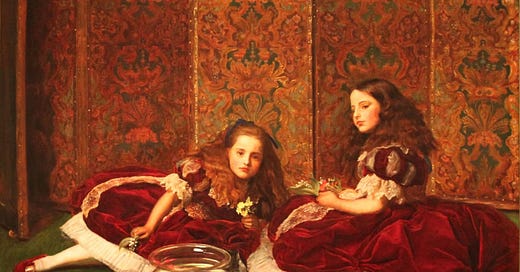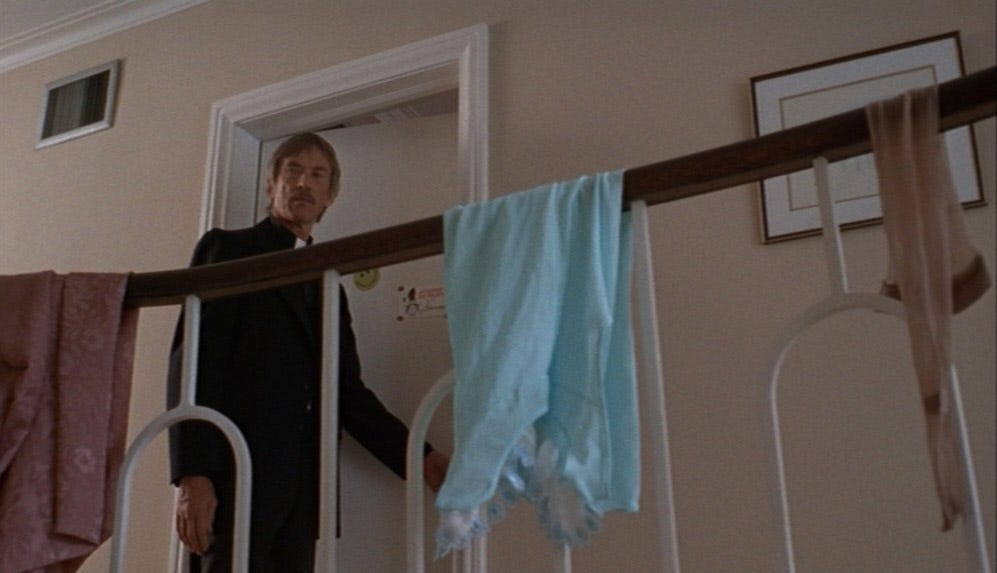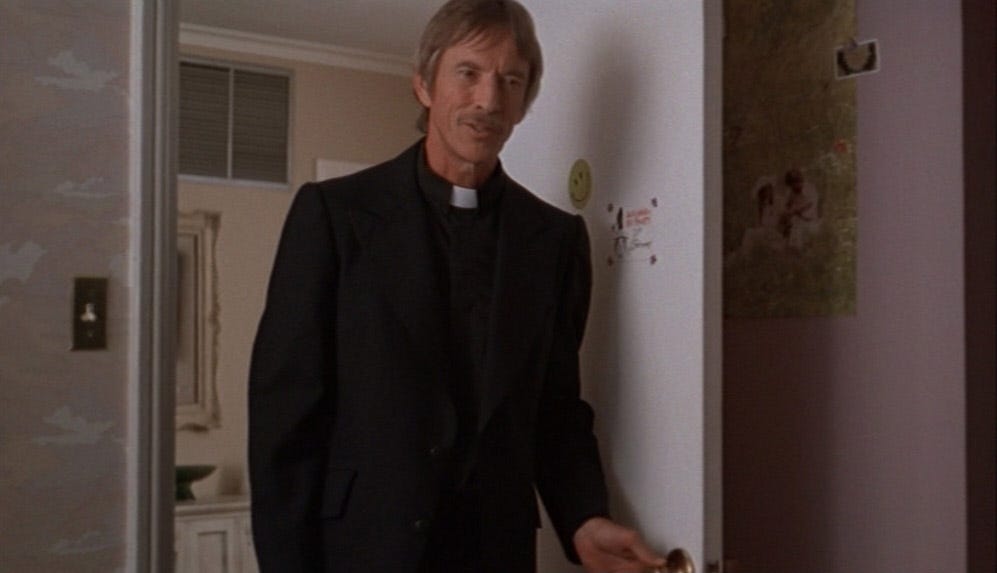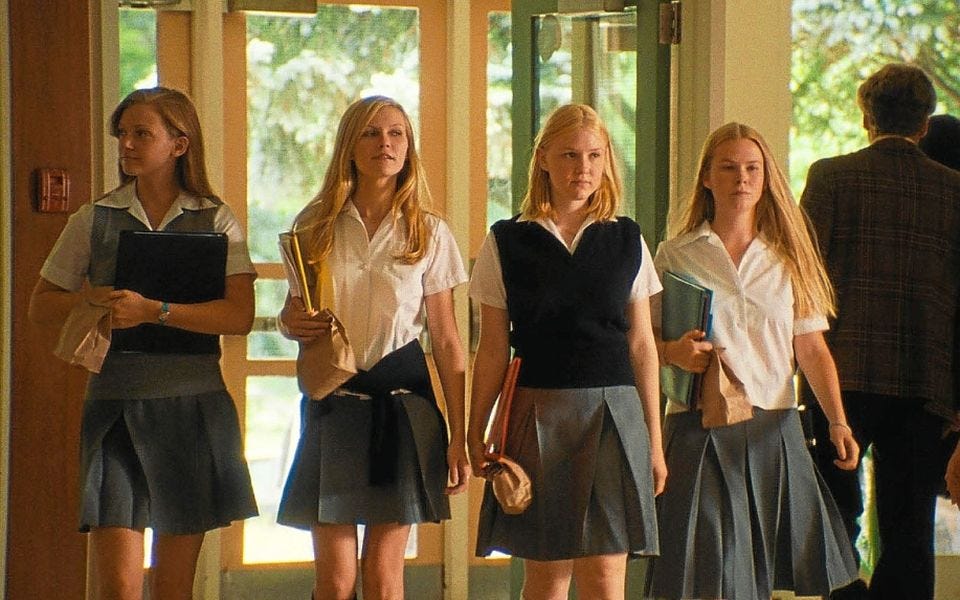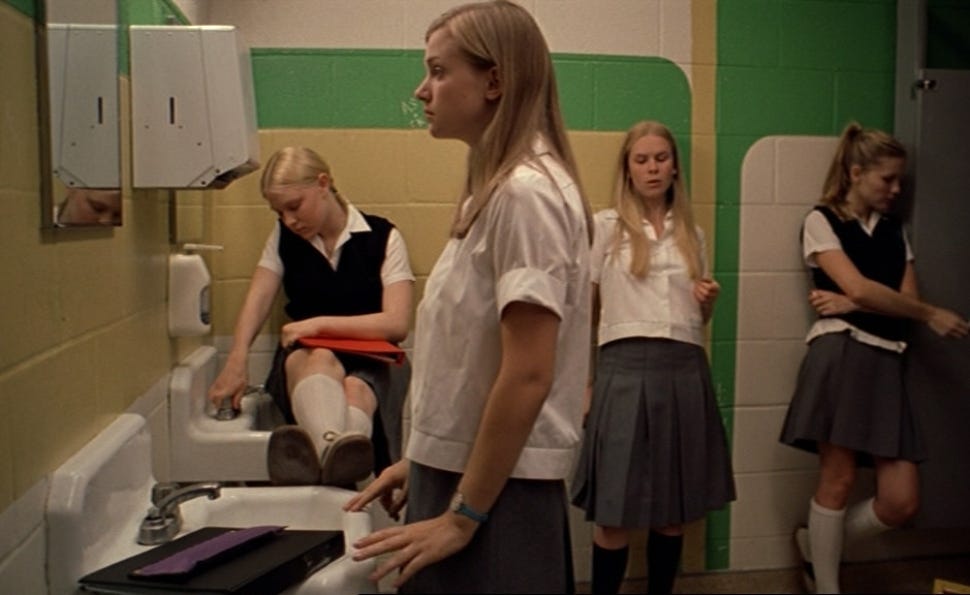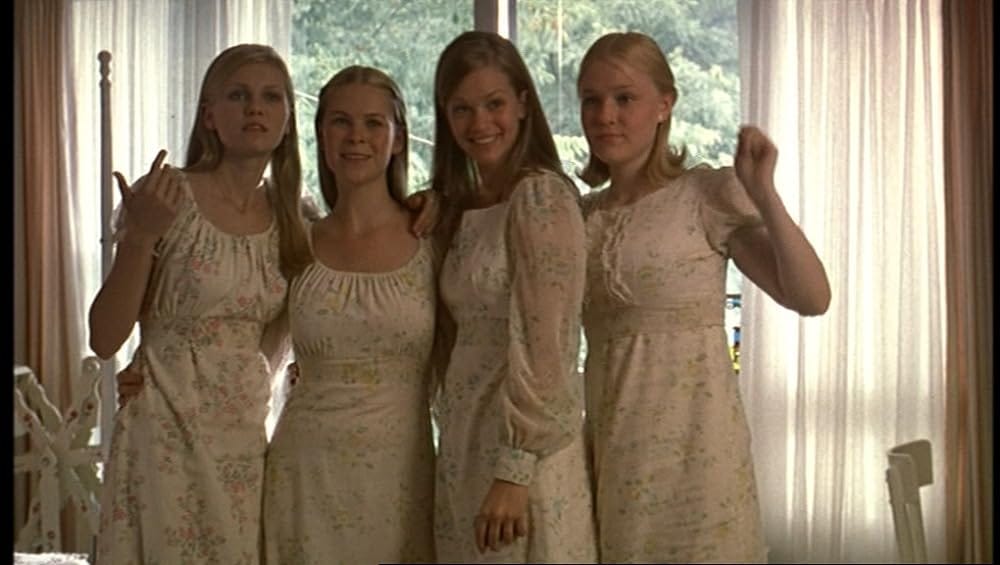'The Virgin Suicides' (1999) at 25: Part II
On the hills like Gods together, careless of mankind
This is the second of a two-parter on The Virgin Suicides. You can find Part I here.
I. Why are we weigh'd upon with heaviness, And utterly consumed with sharp distress, While all things else have rest from weariness? [...] Let us swear an oath, and keep it with an equal mind, In the hollow Lotos-land to live and lie reclined On the hills like Gods together, careless of mankind. — Alfred, Lord Tennyson, “The Lotos-eaters” (1832)
II.
Among the most common adjectives critics have used to describe the mood and aesthetic of Sofia Coppola’s The Virgin Suicides are:
All these certainly fit, but it’s the l-words — “languid” and “languorous,” along with related ones like “lethargic” and “listless”— that best capture the unnerving quality of some of the film’s most indelible images. These words convey a heavy-limbed exhaustion, a dwindling, stemming from their grief at the loss of the youngest sister, Cecilia, and a torpidness born out of their subsequent isolation at home.
III.
The Lisbon quintet of inscrutable sisters are the subject of much speculation among the lusting neighborhood boys — and their gossiping parents — long before Cecilia’s death, and especially after. One patriarch, the family’s priest Father Moody (Scott Glenn), visits the home soon after the funeral to find another patriarch, Mrs. Lisbon (James Wood), engrossed in a baseball game, likely in denial, and unwilling or unable to engage. As Moody, the first outsider to step foot inside the doomed family’s house since the (first, and hardly the last) tragedy, moves upstairs in search of Mrs. Lisbon (Kathleen Turner), he takes stock of the home’s state, betraying, perhaps, his own morbid curiosity. Mounting the stairs, he peers at a plate of moldy, unfinished food and notes the surviving girls’ clothing and hosiery strewn across the bannister. Like the jilted Miss Havisham, time, in this house, has stopped. After absorbing the stray details, Father Moody slowly enters the girls’ room.
Stefanie Zacharek, in a review from film’s release in 2000, is quite perceptive about this moment:
After Cecilia’s death, the Lisbon home takes on a dullish cast, becoming heavy with grief and awkwardness. Coppola captures it with just a few shots: A priest comes to bring solace to the family and opens the door to one of the girls’ rooms, where he finds them, silent and listless, arranged in a haphazard starfish shape on the floor, a tableau of youthful beauty rendered lethargic and numbed by sorrow.
SHOT 1:
SHOT 2:
SHOT 3:
To call this tangle of teenaged girls a “starfish” is to recognize that throughout the film they function as if appendages of a single organism. With the exception of Lux (Kirsten Dunst), rarely are they seen apart from one another, often arriving at school four abreast, congregating alone in school bathrooms, and, during their sequestration, lying near or atop one another in enervated recline.
SHOT 4:
SHOT 5:
So much of The Virgin Suicides is distilled in the scene of Father Moody’s encroachment into the girls’ private realm, a space that the neighbor boys speculate upon and later catalog in forensic detail. In nightgowns and pajamas, the four surviving sisters, ever the object of prying, curious, or lustful gazes, are perched upon one another, locked in a formation that feels at once posed and perfectly natural, just-so yet stumbled upon.
It recalls Pre-Raphaelite painter John Everett Millais’ Leisure Hours (1864), wherein two sisters in a domestic setting rest upon the carpeted floor, one reclined, one sitting. Pointedly, Millais conspicuously places a fishbowl with a pair of goldfish in front of them as the girl on the left stares back at the painting’s beholder. The four of them, the painting suggests, are there to be looked at, all in their own ways confined, though by no means resigned to it.
What’s most remarkable about this Millais-echoing scene from Coppola’s film is that the sisters do not budge at the intrusion of a man — and a priest, no less — into their sphere of intimacy. Recall: these are the same girls whose modesty-obsessed mother, according to the narrator, “added an inch to the bust line and two inches to the waist and hem,” resulting in “dresses [that] came out as four identical sacks.”
SHOT 6:
Despite being reposed in what would be considered in their repressive household a state of relative undress, the girls do not snap to attention, they do not cover themselves. Bare limbed, draped in slinky pink and floral cottons, they meet Father Moody’s gaze — all gazes, for that matter — with an indifference that approaches defiance. When he asks them a question, they do not bother to respond. Instead, their stares dismiss him, and he promptly obliges.
IV.
Freud, as if throwing up his hands in exasperation and unveiling his own racism and misogyny in the process, once wrote that it is unsurprising that “we” — and who might this we be? — “know less about the sexual life of little girls than of boys. [...] After all, the sexual life of adult women is a 'dark continent' for psychology.”1 In The Virgin Suicides, men and boys look — and look and look and look, over and over again — at the Lisbon girls in the hopes of unearthing their motives and desires, and find nothing. I say this not to subscribe to Freud’s belief in the unfathomability of women and girls, nor to endorse or romanticize the Lisbon siblings’ solution to their compounding, crushing imprisonments. Rather, I wonder aloud if it might be productive to see these girls, their impulses, and their fates, as akin to those in Tennyson who eat from the lotus tree: surveying their options, weary in the face of expectations and constraints placed upon them, they elect to “lie reclined / On the hills like Gods together, careless of mankind.”
Sigmund Freud, The Question of Lay Analysis, New York: W. W. Norton, 1950, p. 43


